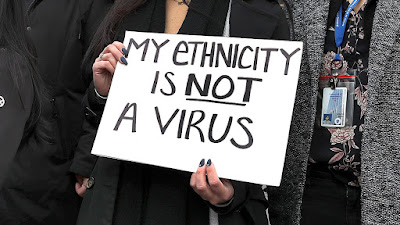 |
| Image source: NPR |
Topics: Civics, Civil Rights, Existentialism, Human Rights
Barbara Stanwyck: “We're both rotten!”
Fred MacMurray: “Yeah – only you're a little more rotten.” -“Double Indemnity” (1944)
Those lines of dialogue from a classic film noir sum up the state of the two political parties in contemporary America. Both parties are rotten – how could they not be, given the complete infestation of the political system by corporate money on a scale that now requires a presidential candidate to raise upwards of a billion dollars to be competitive in the general election? Both parties are captives to corporate loot. The main reason the Democrats' health care bill will be a budget buster once it fully phases in is the Democrats' rank capitulation to corporate interests – no single-payer system, in order to mollify the insurers; and no negotiation of drug prices, a craven surrender to Big Pharma.
But both parties are not rotten in quite the same way. The Democrats have their share of machine politicians, careerists, corporate bagmen, egomaniacs and kooks. Nothing, however, quite matches the modern GOP.
To those millions of Americans who have finally begun paying attention to politics and watched with exasperation the tragicomedy of the debt ceiling extension, it may have come as a shock that the Republican Party is so full of lunatics. To be sure, the party, like any political party on earth, has always had its share of crackpots, like Robert K. Dornan or William E. Dannemeyer. But the crackpot outliers of two decades ago have become the vital center today: Steve King, Michele Bachmann (now a leading presidential candidate as well), Paul Broun, Patrick McHenry, Virginia Foxx, Louie Gohmert, Allen West. The Congressional directory now reads like a casebook of lunacy.
It should have been evident to clear-eyed observers that the Republican Party is becoming less and less like a traditional political party in a representative democracy and becoming more like an apocalyptic cult, or one of the intensely ideological authoritarian parties of 20th century Europe. This trend has several implications, none of them pleasant.
Excerpt from "Goodbye to All That: Reflections of a GOP Operative Who Left the Cult," Mike Lofgren, Truthout, September 3, 2011
September 3, 2011 was a year before the re-election campaign of the first African American president, and the quixotic attempt to make him a "one-term president" by now Black Lives Matter Senator Mitt Romney, the goal was clearly stated by Michele Bachmann, Moscow Mitch McConnell and a whole host of characters that might as well have been the compost for the garden variety bullshit metastasized into our current COVID harvest.
Arizona has spiked. Oklahoma has spiked. Orange Satan's resuming in-person campaigning, and bullying schools to put their children through the flaming arms of Moloch this fall, so that the remnant of parents, teachers, principals and janitors that SURVIVE limp the hulking carcass of this economy over the finish line November 3, 2020 towards the re-election of Damien Thorn. Whatever the previous Republican Party's "principles" were, they jettisoned when an improbable black man with a funny name actually won the presidency, making history of course, but he wasn't supposed to. Running's aloud; winning's not.
Frederick Douglass was nominally a presidential candidate at the 1888 Republican convention by one vote. George Edwin Taylor became a candidate of the newly-formed (and brief) National Negro Liberty Party in 1904. Channing E. Phillips received 67.5 votes at the 1968 Democratic convention, the same year Nixon won. Shirley Chisholm was a candidate four years later for the DNC, earning 152 delegates. Jesse Jackson (Aggie Alumnus) garnered 3 million votes in 1984 and 7 million votes in 1988. Reverend Al Sharpton and Senator Carol Moseley-Braun and republican Alan Keyes also ran (2000, 2008). Herman Cain, Ben Carson, Kamala Harris, Cory Booker and Massachusetts Governor Deval Patrick was a late entrant into the race for this cycle. Source: Wikipedia
Until President Obama, the "hounds tooth" of white supremacy was remarkably efficient in barring people of any color from the nation's highest office. We also stand firmly as the only nation that has NEVER had a female executive, and until 2008, firmly held the line that whether (D) or (R), the reins of ultimate power would be held by white males 43 times from George Washington to George W. Bush. November 4, 2008 rocked their world.
Barack Obama was to them, a living nightmare: the personification of the demographics bomb they themselves caused with free trade policies that all but eliminated the central class in Central America. It was essentially an extension of slavery and indentured servitude. Builders et al., who payed workers in bags of cash so they didn't have to report them to the IRS, are suddenly freaked out those same people had children, who become citizens and most likely: won't understand their nostalgia for white picket fences and red-lined districts. Superbowl commercials celebrating diversity were denigrated if they didn't remind them of Norman Rockwell paintings, i.e., of themselves as the epitome of humanity. The "evil empire" of their patron, Saint Reagan, didn't look so evil and the PR was changed - common sense ignored - to reflect it. Fascism is nothing if not based on fear.
Death cult: A fringe religious group that glorifies or is obsessed with death. Oxford English dictionary
That Monday night, Texas Lieutenant Governor Dan Patrick seemed to go full Midsommar—a horror movie about a fictional Swedish death cult that sacrifices their elders—by saying that ”as a senior citizen” he was “all in” on “willing to take a chance on [my] survival in exchange for keeping the America that all America loves.”
Right-wing internet commentator Jesse Kelly tweeted on Tuesday morning that, “If given the choice between dying and plunging the country I love into a Great Depression, I’d happily die.”
Glenn Beck on Wednesday said that he too was ready to risk his life for the stock market, in a stream following a town hall in which Trump floated a return to reopening businesses and public gatherings by April 12, an ambition that Beck conceded could be a death sentence for thousands of Americans—himself included.
If all that sounds to you like the dangerous, macabre ramblings of a movement willing to sacrifice human life for illusory gains, you’re not alone. “I dealt with suicidal cults before. I encountered people who are willing to die for their faith, ideology, race, etc. But, I never encountered anyone who is willing to die for someone else’s 401k,” tweeted Ali Soufan, a former FBI agent who now runs an intelligence and security consultancy. “This is a whole new level of craziness.”
Formal experts on destructive cults agreed with Soufan’s diagnosis of Trump and his base’s support for letting some die. When I reached him via a Zoom video call, Steve Hassan, a mental health professional and cult expert, started nodding immediately when I asked if he saw parallels between, say, the Jonestown Massacre and Trump’s willingness to put the elderly on a near literal chopping block. Ben Zeller, a professor at Lake Forest University who focuses on new religions and Daniel Shaw, a New York-based psychoanalyst who has helped counsel people who have left cult religions, agreed with almost no hesitation.
Cult Experts Warn That Trumpism Is Starting to Look Awfully Familiar, Ali Breland, Mother Jones
Mike Logren called it. We are now well past the bug-eyed point with Bachmann.
Fear can motivate irrational behavior. A party with authoritarian tendencies will ignore facts, science and reality, thus, climate change, universal healthcare and COVID mask protocols are immediate non-starters. A party that cannot garner enough votes or convince enough women, LGBT, black or indigenous people of color and youth will simply block, or purge them. A party that fears oblivion might sell our national soul to a Russian devil, cavorting with them openly July 4, 2018. What then, are the "in the event of election landslide, break glass" instructions?
We're beyond the crazy bug-eyed, chrysalis of madness to fully-emerged, political dementia - the kool-aid moment of the republic, and we're a tweet away from Armageddon.

















